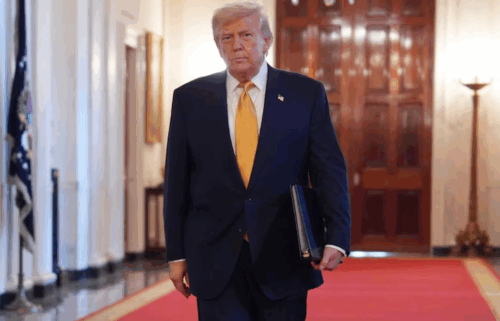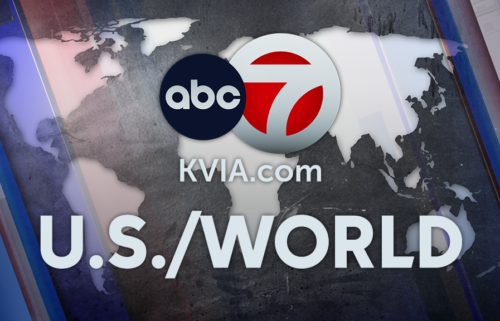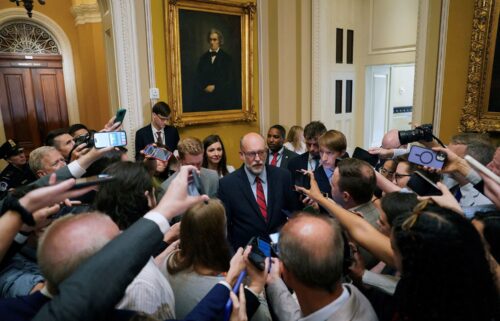How the jailing of pro-independence leaders triggered unrest in Catalonia
Road blockades, street clashes and burning containers: furious protests across Catalonia continued for a fourth day on Thursday, triggered by the lengthy prison sentences handed to pro-independence politicians this week.
On Wednesday night, demonstrators in Barcelona and other cities set garbage containers and cardboard on fire, while some threw cans, stones, and flares at riot police. “The streets will always be ours,” protesters have been chanting.
Thirty-three arrests were made on Wednesday in the northeastern autonomous region, according to the Spanish Ministry of Interior. 97 injured people were attended to by the Catalan emergency services — 36 of them members of the security forces.
On Thursday, protesters continued to block highways across Catalonia, while in Barcelona, police were pelted with eggs and water bottles as thousands of students rallied.
With more demonstrations scheduled and a worker’s general strike planned for Friday now morphing into another independence protest, Spain is on edge. But how did it come to this?
The prison sentences which led to violence
On Monday, the Spanish Supreme Court handed down prison sentences of between nine and 13 years to nine Catalan independence leaders for their part in a failed attempt to split from Spain in 2017.
Acquitted of the most serious charge of rebellion, they were convicted variously of sedition, misuse of public funds and disobedience.
Oriol Junqueras, the former vice president of Catalonia, was handed the longest sentence, jailed for 13 years and banned from holding public office for the same length of time after being found guilty of sedition and misuse of public funds. The others received prison terms of between nine and 12 years.
Initially peaceful, the demonstrations against the sentences have become battles between protesters and police.
On Monday, hundreds of people marched to Barcelona’s El Prat airport, as well as blocking roads and train tracks across the region.
Video footage from the airport showed police using batons on protesters outside the building, as traffic cones were hurled at officers. According to AENA — the airport operator — 108 flights were canceled.
It has been widely reported that many protesters have been throwing toilet rolls in the air, an acknowledgment to the demonstration slogan: “There’s a lot of s**t to clear up.”
Who are the protesters?
Spain’s caretaker Prime Minister Pedro Sanchez blamed the protests on “organized violent groups.”
Catalonia, a wealthy semi-autonomous region of around 7.5 million people, has its own language, parliament, flag and anthem, and Catalan separatism has long prided itself on being a peaceful movement.
Meritxell Budo, a spokesperson for the pro-independence Catalan regional government, emphasized this on Twitter, describing the movement as “peaceful and democratic.”
“Images like these are intolerable,” she wrote, alongside images of streets with fire raging in the background. “No words or excuses. The independence movement is peaceful and democratic and there are no reasons to justify this.”
Catalan President Quim Torra blamed the violence on infiltrators trying to undermine the movement. “We cannot allow groups of infiltrators who want to damage our image, the image of millions of Catalans who take to the streets in a serious way, we will not fall into their trap,” he said in a televised statement on Wednesday.
“We will not tolerate them. We cannot tolerate that few who do not represent us now represent independence.”
‘This has to stop now’
Torra also urged an end to such actions.
“The independence movement is not and has never been violent, we have always condemned and condemn violence, these incidents cannot be allowed in our country,” he said.
“There is no reason or justification to justify any act of vandalism. The protests must always be peaceful. and that is how we don’t lose rightness.”
Torra, criticized in some quarters for calling for civil disobedience while sending in Catalan riot police to restore order, had earlier this week described Monday’s sentences as an “act of revenge, not of justice” by the Spanish government.
He told the regional parliament on Thursday that another referendum on Catalan independence should be held.
Prior to Torra’s statement on Wednesday, Sanchez had appealed to the Catalan president to denounce the violence.
After holding talks with other political parties, Sanchez said that Madrid would not be provoked into overreacting.
“The government of Spain acts and will continue to act with all the mechanisms of the state to guarantee the full validity of fundamental rights and the maintenance of order in Catalonia, including the right to peaceful demonstration,” said Sanchez.
“The government of Spain opposes, and will continue to oppose any form of violence against people, against public property, as we are seeing in the city of Barcelona, and also against private property, on the part of organized violent groups or isolated violent individuals.”
Junqueras tweeted: “All our support for the demonstrations and massive and peaceful marches. Violence doesn’t represent us.”
What happened in 2017?
In 2017, Spain descended into its worst political crisis since the restoration of democracy in the 1970s, when separatist leaders attempted to push forward with the region’s secession.
Police and protesters clashed in the streets as a referendum — ruled illegal by Spain’s constitutional court — went ahead and was followed by a declaration of independence in October that year.
Turnout for the referendum was low and marred by a bloody police crackdown — scenes which shocked Catalans and the international community, and led to Madrid’s representative to Catalonia later apologizing for the violence.
The Spanish government dismissed the entire Catalan executive and parliament, later holding new regional elections that December which again resulted in pro-independence parties winning the majority of seats.
What drove the bid for independence?
Catalonia is the richest of Spain’s 17 autonomous regions. The regional government holds considerable powers over healthcare, education, and tax collection, but it still pays tax to Madrid, and separatists argue that complex mechanisms for redistributing tax revenue are unfair on wealthier areas.
Catalonia has long complained that its revenues subsidize other parts of Spain. The region hosts some 16% of the Spanish population and much of the country’s manufacturing and finance sectors.
Catalan nationalists argue that they are a separate nation with their own history, culture, and language and that they should have increased fiscal independence.
The Catalonia question had been bubbling away for years, but gained momentum after Spain’s economy plunged during the financial crisis in 2010. It was further galvanized by the Scottish referendum for independence in 2014, which ultimately saw voters opt to remain part of the United Kingdom.
What happens next?
It is difficult to predict what the ultimate outcome could be. The Spanish government has set up an emergency committee to deal with the protests, but if things turn very ugly, it could opt for extreme measures, such as triggering Article 155 of the constitution.
That would allow the government in Madrid to impose direct rule on Catalonia, which it did in 2017 for the first time in the country’s history.
The legislation allows for central intervention if an autonomous government “fails to fulfill the obligations imposed upon it by the constitution or other laws, or acts in a way seriously prejudicing the general interests of Spain.”
On the other hand, the situation could continue as it is, with Madrid perhaps hoping that the protesters will eventually run out of steam.
Is it safe to travel?
The US Overseas Security Advisory Council (OSAC) has advised visitors that Friday’s planned general strike will likely affect services throughout Catalonia, including public transport and businesses.
“Protesters have also called for demonstrations at Barcelona airport during the weekend,” read a statement.
OSAC recommended that areas where demonstrations were taking place be avoided and said those visiting the region should monitor local media for updates and keep a low profile.
The UK government said tourists in Barcelona and other areas of Catalonia should “exercise caution in the vicinity of demonstrations as they may occur with little or no warning.”




